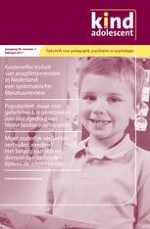01-06-2007 | Artikelen
Surfen, chatten en internaliserende problemen
De rol van kwaliteit van vriendschap
Gepubliceerd in: Kind en adolescent | Uitgave 2/2007
Log in om toegang te krijgenSamenvatting
In dit onderzoek zijn bij 307 adolescenten (gemiddelde leeftijd 15 jaar) de longitudinale effecten van internetgebruik op internaliserend probleemgedrag onderzocht. Daarbij is onderscheid gemaakt tussen internetgebruik gericht op communicatie (‘chatten’) en internetgebruik niet gericht op communicatie (‘surfen’). Tevens is de modererende rol van de kwaliteit van de beste vriendschap in de effecten van internetgebruik op probleemgedrag onderzocht. De resultaten geven aan dat voor adolescenten met een lage kwaliteit van vriendschap langer chatten minder internaliserende problemen voorspelt, terwijl in die groep langer surfen juist meer internaliserende problemen voorspelt. De resultaten leveren ondersteuning voor de associatie tussen eerder internetgebruik en latere toenemende of afnemende internaliserende problemen, maar kunnen niet automatisch geïnterpreteerd worden in termen van causale verbanden tussen internetgebruik en latere internaliserende problemen.
